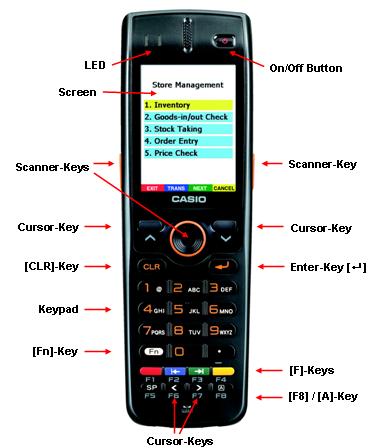
|
| Q: | LED |
| A: |
Status indication with left LED for battery (green = fully charged, orange = charging) and right LED for scanner (green = success, red = error), Bluetooth (blue), PC connection (magenta) and WLAN (orange). |
| Q: | Screen |
| A: |
Use either the Cursor-Keys or the Mouse-Emulation to navigate. |
| Q: | Trigger-Keys |
| A: |
The scanner can read data from a label. By pressing one of the trigger-keys the scanner will be activated while the scanner software is running. Further keys can be configured if necessary. |
| Q: | Cursor-Keys |
| A: |
The cursor-keys serve in principle to change between switching surfaces represented on the screen or to move the insert mark in input fields. Alternatively, you can activate the Mouse-Emulation by pressing [Fn] + [4]. |
| Q: | Keypad |
| A: |
Via the keypad you enter numbers and letters. To switch between numbers and letters use the key [A]. In the status line at the lower edge of the screen the selected input method is shown symbolically. |
| Q: | Enter-Key |
| A: |
With the enter key inputs are finalised. Thus the program is instructed to accomplish the action chosen by you, for example use a selected button or store an entered number. |
| Q: | [CLR]-Key |
| A: |
The CLR-Key ("Clear"-Key) deletes the marked data in an input field, or rather the character left to the cursor. The key combination [Fn] + [CLR] leaves the actual screen if it is a simple dialogue window. |
| Q: | [Fn]-Key |
| A: |
With [Fn] - key additional input functions can be activated. In the status line at the lower edge of the screen the activated [Fn] - key is shown symbolically. By the gradual combination of an [Fn] - key and a further key you will reach the following functions:
| [Fn] + [0] |
Fade in or out the software input panel |
| [Fn] + [1] |
Switch on or off the backlight |
| [Fn] + [2] |
- |
| [Fn] + [3] |
- |
| [Fn] + [4] |
Mouse-Emulation on/off |
| [Fn] + [5] |
Darken the backlight |
| [Fn] + [6] |
Brighten the backlight |
| [Fn] + [7] |
Starts a program (full path must be saved to Registry) |
| [Fn] + [8] |
Starts a program (full path must be saved to Registry) |
| [Fn] + [9] |
Starts a program (full path must be saved to Registry) |
| [Fn] + [.] |
Display the character "-" |
| [Fn] + [CLR] |
Display the functional character ESC |
These key combinations are pre-installed and can be deactivated via the Registry. |
| Q: | [F]-Key / [A]-Key |
| A: |
The F-Keys [F1] to [F8] are related to the following functions:
| [F1] |
Menu (ALT, or VK_MENU respectively) |
| [F2] |
Back-Tabulator (VK_SHIFT + VK_TAB) |
| [F3] |
Tabulator (VK_TAB) |
| [F4] |
Function Key F4 (VK_F4) |
| [F5] |
Space Key |
| [F6] |
Left Cursor |
| [F7] |
Right Cursor |
| [F8] / [A] |
Switching Input Mode |
By using our System Library API you can assign other key codes, e.g. the real key codes from F1 to F8. |
| A: |
On some devices from CASIO, functions keys are mapped to special functionality in order to provide easy navigation. This sample application remaps hardware keys F1 to F8 and assigns key codes "F1" to "F8". As a result, functions keys can be used as they are labeled, e.g. for terminal emulation. |
| |
FKeyMapper.zip |
16.05.2018 |
App to map Function Keys to F1 - F8 (Windows Embedded CE) |
1.01 |
|
|
| |